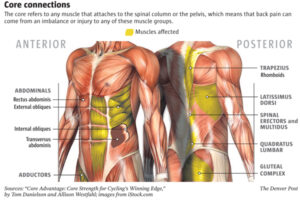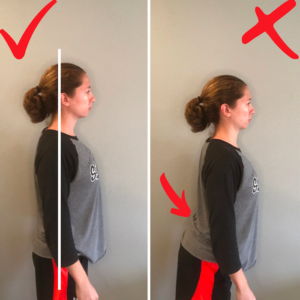Balance is pretty important. It helps you avoid falling down and embarrassing (or injuring) yourself. Even more importantly, having good balance improves your athletic ability.
You’ve probably seen countless articles and Instagram posts about balancing on Swiss balls and BOSU balls to improve your balance and coordination. While there’s a place for stability balls in an otherwise well-rounded strength training program, they’re not the end-all-be-all of balance training.
Your best bet is to strengthen the muscles involved in balancing and emphasize single-leg exercises done on the floor (which is what people generally walk around on in real life, so… yeah, start there).
The muscles that help you balance are part of the “lumbo-pelvic-hip complex” and your core, which includes the entire 360* around your spine.
Specifically, we’re talking your gluteus medius (side hip muscle), gluteus maximus (your butt), hip flexors, adductors (inner thigh), obliques, deep core stabilizers, erector spinae (close to your spine), and lower and middle back muscles. Check out the image to get a better idea of where these muscles are located on your body. Long story, short: you have to train more than your “six-pack” muscles to build a strong, stable core.

Badass Core Training
Your core’s main job is to protect your spine from external forces, so the best exercises to strengthen and stabilize your LPH complex, abs, and back are “anti-” exercises that require you to resist movement from your spine.
- Anti-extension: front plank; dead bugs; ab wheel rollouts
- Anti-rotation: Paloff press variations
- Anti-lateral flexion: loaded carries; offset loaded squats, lunges, step ups
Anti-extension
Any exercise that requires your muscles to resist extending through the spine (typically, your lower back) is an anti-extension exercise.
Excess extension looks like Donald Duck or Kardashian butt. We want to avoid that position because it puts too much pressure on the lower back, so we’ll train “anti-extension” to help the abs and hips maintain a more neutral/natural pelvic position.

A helpful cue to think about when doing any of these exercises is to tuck your ribs toward your pelvis, kind of like you’re about to do a crunch, but without actually crunching.
Front planks from both push-up position and on your forearms are a good way to train anti-extension. Push ups themselves are another good exercise, as long as you use the “tuck your ribs toward your pelvis” cue. Other exercises I really like are dead bugs and ab rollouts.
Anti-rotation
Any exercise that requires your muscles to resist rotating through the hips and/or shoulders is an anti-rotation exercise. The best way to train this is with “Paloff” press variations.
Anti-lateral flexion
Any exercise that requires your muscles to side-bending is an anti-lateral flexion exercise. The best way to train this is with offset loading.
For instance, you could do a suitcase carry, single arm deadlift, single kettlebell front rack squat, single kettlebell split squat, or step ups with a one weight in your hand or the racked position. Some examples are shown here.
Badass Balance Training
When it comes to balance, standing or squatting on a BOSU ball isn’t your best option. Strength comes from moving heavy weights, and you cannot lift as heavy when you’re on an unstable surface. That doesn’t mean you can’t train in less stable environments, though. Enter unilateral or single-leg training.
Unilateral Strength Exercises
Single-leg exercises force your lumbo-pelvic-hip stabilizing muscles to engage so you keep your balance. These exercises can also help even out any strength/muscle imbalances your body naturally develops from favoring your dominant side.
Some of the best single-leg exercises to improve your balance include: split squats, step ups, lunges, pistol squats, single leg bridges and hip thrusts, split-stance deadlifts, and single leg deadlifts.
Pick 2-3 exercises and perform 3-4 sets of 6-10 reps per leg for each exercise.
Balancing Exercises
Stand with your feet under your hips. Pick up one foot and use your hip flexors to raise your knee to hip height. Stand there.
Now, close your eyes. Notice how the small muscles in your foot and ankle start freaking out (making constant, minor corrections) to help you stay balanced.
Simply practicing balancing on one leg is a great way to get better at balancing. If you can balance on each leg for one minute with your eyes open, try it for one minute per leg with your eyes closed. Once you’ve mastered that, you can add fancier balancing drills, starting with standing on a soft object like a folded towel or yoga mat.
To take things up a notch, balance on one leg and move the other leg. Single leg deadlifts are a good example of this, as are toe taps.
Single leg chops help you balance while resisting rotation, which is a cool double-whammy.
In conclusion: Ditch the BOSU ball, already!
Just because you’re standing or squatting on a BOSU ball, doesn’t mean you’re getting better at balancing. Balance is a skill that requires full-body strength and coordination. Focus on strengthening the muscles involved in balancing, and you’ll improve your posture, balance, core strength, and athleticism.
